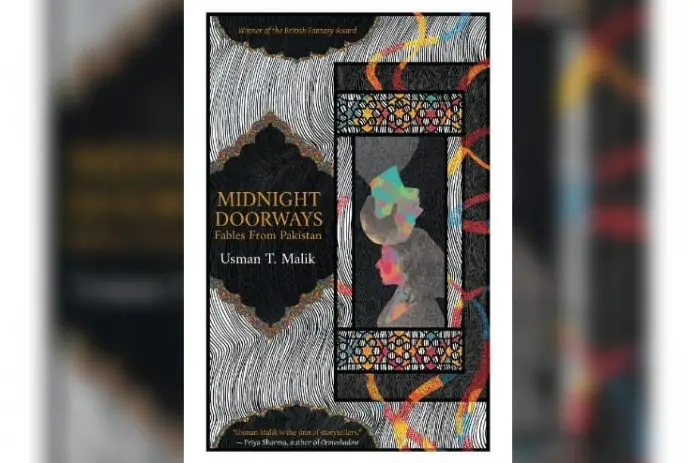“Midnight Doorways: Fables from Pakistan” is an anthology of short stories written by the widely-acclaimed and award-winning writer, Usman T Malik, who also happens to be the first Pakistani author to have won a Bram Stoker, which is a British dark fantasy and horror writing award.
Published by Kitab, with the cover design by Mushba Said that speaks volumes about the book’s content, the anthology centers on the deep, dark and uncanny – death being a recurrent theme in each of the seven stories.
Malik’s book is a mix of horror, sci-fi, speculative fiction, mystery, fantasy and magical realism, thus difficult to label with a single genre. It seems to be in accordance with Malik’s belief that to confine a piece of art to one genre is to rob it of its originality and charm. His work in his own words “pushes the boundaries of realism”.
Malik’s characterization and depiction of an unreal and horrific environment is perhaps what makes him shine and stand out amidst the typical trend of South Asian fiction. His approach is unique and authentic, combining the scientific with the irrational in a remarkable manner. With an extensive knowledge base, the way the author executes and expresses himself is hypnotic, making it hard for the reader to put the book down.
The stories are captivating and mesmerizing, as if they are out of a fairytale book, putting multiple, daunting questions before the readers. What happens at midnight is one such question, answered with stories that highlight the fear and trepidation brought about by midnight. Ghosts, murders, death, sinister magic, dangerous seduction, and the fear of the unknown keep the reader hooked onto the book, who experiences an unease resulting from the stories’ unpredictability.

However, the collection, despite being disturbing and murky does not fail to include a compassion for human frailty and loss.
Although the stories are rooted in our indigenous land, the way Malik blends the city and its social issues with the supernatural is incredible! He entwines the myths, legends and scary stories of djinns and ghosts with the rational, taking us through an enchanting journey of love, hatred, drug usage, terrorism and orphan-age. Follows my favourite quote from the first story titled “Ishq”:
Ishq means the state of a lover’s heart during separation, contemplation or annihilation unto the lover. The point where the lover becomes the beloved. Sometimes it also means nostalgia for a love forever gone, a love that never was and love that remains after death.
Malik beautifully paints the pain and agony of having lost a loved one. Love is like a flower that blooms and then withers. Malik questions the permanence of love. Is love fleeting? Is it ethereal?
“The Wandering City”, the second story, talks about the enchanted city of Lahore and describes it as a “city haunted by its own people. Forever, alive in death.”
Malik highlights the perils of midnight when the tombs open and the city wanders.
The third story titled “Resurrection Points” centers on religious discrimination. The rift between Muslims and Christians and the bias against non-Muslims is at the core of the story, hence the quote “Someone once told me dust has no religion” which beautifully sums up the futility of such issues. The story teaches that religion is not a ground to hurt and kill the impure (pun intended). It is unfair to kill non-Muslims in the name of purging the country of the devils.
“Dead Lovers on Each Blade, Hung” is my favourite out of the collection. It talks of the love between Hakim Shafi and his child bride, Maliha. The story is told through a conversation between a heroinchi, a sub inspector and the Hakim himself. What sets the story apart is its fusion of the imaginary with the practical.
Another story, “The myth of the Serpent King and his Queen” takes the reader through a magical journey. It reminds one of Greek Mythology with the underworld and its adventures. The following quote from the story points towards the reality of love:
Hakim Shafi was maddened by love. What kind of love, I didn’t dare ponder.
Is love really so paranoid? Does it take away the ability to think rationally?
She once told me she loved snakes. Because when they shed their skins, they live anew. She said snakes are lovelier than butterflies, for a cocoon hides a butterfly’s ugly childhood, while snakes don’t bother about the artifice of beauty.
What is exquisite about the parallel points is how wild and ravenous the author’s imagination is. Whilst snakes are loathed and butterflies loved for their delicacy, the author turns the simile upside down. The story also talks of the brutality of child marriages yet the inflection with which he brings forward this grave issue is extra-ordinary. He makes it sound jocular and describes the notion of love in such a way that the reader does not feel repulsed by the situation. His demeanor of thinking is exclusive, just like the rarity of an emerald stone.
“In the ruins of Mohenjo-Daro” is the last story in the collection. It is a story of how three professors, Noor, Tara and Junaid take their students to visit the ruins of Mohenjo-Daro. As the journey unfolds, it spreads fear and chaos amongst the group who are forced to spend the night in the museum because of a terrorist attack in Dokri. The driver, Hamid, is uneasy for he has heard many a story of how the museum comes to life at night. As the group plunges into the strange and exotic, it brings with it an episode of violence and blood. We can draw a parallel with the film, “A Night at the Museum” which shares a similar theme of fantasy and magic where dead come to life at midnight. The story beautifully links all at once – fables, myths, legends and prophecies.
The book ends leaving the reader feeling satisfied and greedy simultaneously, for it is a heart wrenching anthology with a stylistic approach that one rarely comes across. “Midnight Doorways” is a treat for the eyes, mind and soul!








Comments are closed.